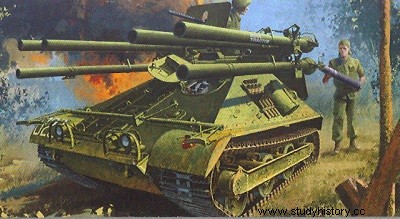
Type: tank destroyer.
Crew :3 men.
Armament :6 recoilless guns of 106 mm; 4 .50 pointing rifles; a .30 machine gun.
Armour
maximum 16mm.
Dimensions:
length: 3.828 m;
width (overall): 2.9 m;
height: 2.133 m.
Weight in combat order: 8.3 t
Ground pressure: 0.33 kg/cm2.
Engine: General Motors Model 302 water-cooled gasoline engine, developing 145 hp at 3,400 rpm.
Performance:
road speed: 48.28 km/h;
range: 70 km;
vertical obstacle: 0.762 m;
clear cut: 1.371 m;
slope: 60%.
Service time: introduced in 1956 into the United States Marine Corps and phased out of service beginning in 1970.
In 1951, the American army launched the study of a light and very mobile tank destroyer, designated T165. After various designs were built and tested, a modified version, the T165E2, received the official green light in 1955. When Allis Chalmers closed production in 1953, 297 examples had rolled off the lines for the Marine Corps. In 1963, 294 M50 or ONTOS received with a new engine the designation of M50A1.
The machine was used in operations in Vietnam and the Dominican Republic.
From 1970, the ONTOS was withdrawn from service and scrapped. But a whole series of vehicles were going to derive from its chassis, in particular a light transport, a mortar carrier and an anti-aircraft machine, then the American army lost interest in the affair and the whole program was canceled.
The ONTOS was armed with six 106 mm M40A1C recoilless guns, arranged three by three on each side of the hull. Two of these pieces, almost identical to those with which the infantry was equipped, could be dismantled and placed in battery on the ground. The recoilless guns pointed in azimuth on 40° on both sides and in elevation from -10° to +20°, the movements in elevation and in azimuth being carried out by manual control. Also used for aiming were four .50 caliber alignment tubes.
The method called for the gunner to line up the recoilless guns on the target and then fire a burst from the aiming tubes; if the bullets hit the target, the gunner knew that the recoilless guns were correctly aimed and could therefore fire a single piece, one, two or three pairs of weapons.
The major flaw was the need for the crew to dismount to reload after six shots.
Furthermore, in the event of a full burst, the ONTOS raised a real dust storm behind it, following the blast of the six pieces.
The ammunition load was 18 shells of 106 mm and 90 shots of .50 for aiming. A .30 machine gun, mounted on top of the vehicle, provided close defense, with 1,000 rounds. The ONTOS forded 0.60 m without preparation or 1.50 m using a special kit.
